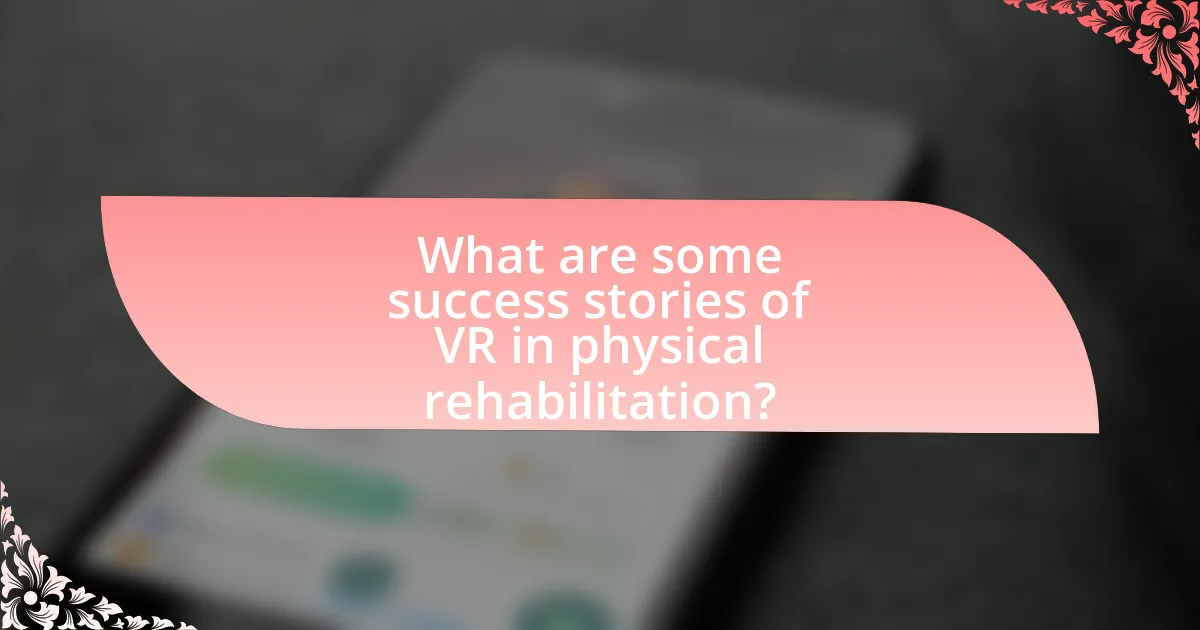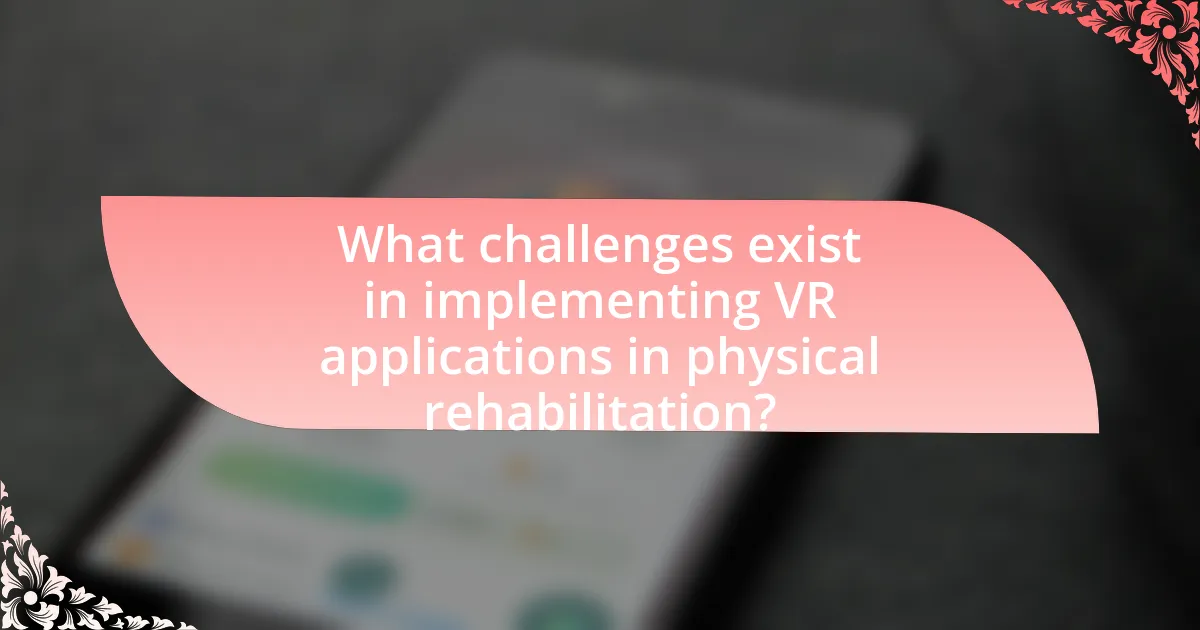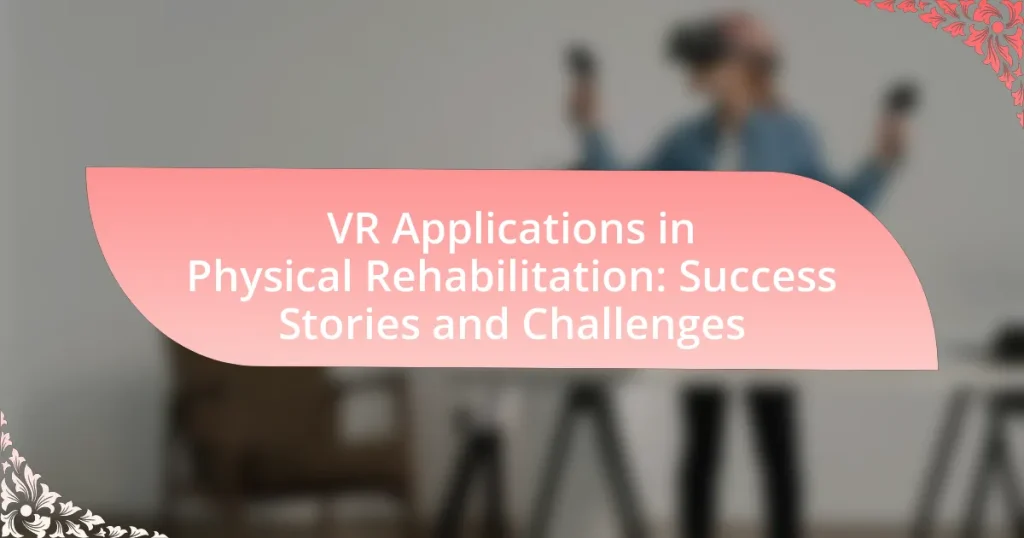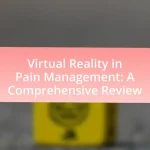VR applications in physical rehabilitation are innovative technologies that utilize immersive virtual environments to aid recovery for patients with physical impairments. These applications enhance therapeutic exercises by simulating real-world scenarios, thereby improving mobility, strength, and coordination while increasing patient motivation and adherence to rehabilitation programs. The article explores various aspects of VR in rehabilitation, including the technologies used, specific conditions treated, success stories, and the challenges faced in implementation. It also highlights the role of healthcare professionals in integrating VR into traditional rehabilitation methods and discusses future prospects and emerging trends in the field.

What are VR Applications in Physical Rehabilitation?
VR applications in physical rehabilitation are immersive technologies designed to enhance recovery processes for patients with physical impairments. These applications utilize virtual environments to simulate real-world scenarios, allowing patients to engage in therapeutic exercises that improve mobility, strength, and coordination. Research indicates that VR can increase patient motivation and adherence to rehabilitation programs, leading to better outcomes. For instance, a study published in the journal “Neurorehabilitation and Neural Repair” found that patients using VR for stroke rehabilitation showed significant improvements in motor function compared to traditional methods.
How do VR applications enhance physical rehabilitation?
VR applications enhance physical rehabilitation by providing immersive environments that motivate patients to engage in therapeutic exercises. These applications utilize gamification and real-time feedback to improve patient adherence and performance, leading to better recovery outcomes. Research indicates that patients using VR for rehabilitation show increased motivation and improved functional mobility, as evidenced by a study published in the Journal of NeuroEngineering and Rehabilitation, which found that VR-based interventions significantly improved motor function in stroke patients compared to traditional methods.
What technologies are utilized in VR rehabilitation?
Virtual reality rehabilitation utilizes technologies such as motion tracking systems, haptic feedback devices, and immersive VR headsets. Motion tracking systems, like those from Microsoft Kinect or Vicon, capture the user’s movements to create real-time feedback in virtual environments, enhancing engagement and motivation. Haptic feedback devices, such as gloves or exoskeletons, provide tactile sensations that simulate real-world interactions, improving the user’s sensory experience and motor skills. Immersive VR headsets, like the Oculus Rift or HTC Vive, deliver a fully immersive experience, allowing users to engage in therapeutic exercises in a controlled and motivating setting. These technologies have been shown to improve outcomes in rehabilitation by increasing adherence to therapy and enhancing the overall effectiveness of treatment.
How do VR applications simulate real-world scenarios for patients?
VR applications simulate real-world scenarios for patients by creating immersive environments that replicate everyday activities and challenges. These applications utilize advanced graphics, haptic feedback, and motion tracking to engage patients in realistic tasks, such as walking, reaching, or interacting with objects. Research has shown that this immersive experience enhances motor learning and rehabilitation outcomes, as evidenced by a study published in the Journal of NeuroEngineering and Rehabilitation, which found that patients using VR for rehabilitation demonstrated significant improvements in balance and mobility compared to traditional methods.
What types of physical rehabilitation benefit from VR?
Virtual reality (VR) benefits various types of physical rehabilitation, including stroke recovery, orthopedic rehabilitation, and neurological rehabilitation. In stroke recovery, VR can enhance motor skills and cognitive function through engaging simulations that encourage movement and coordination. Orthopedic rehabilitation utilizes VR to improve range of motion and strength post-surgery by providing interactive exercises tailored to individual recovery needs. Neurological rehabilitation employs VR to assist patients with conditions like Parkinson’s disease or traumatic brain injuries, offering immersive environments that promote balance and coordination. Studies have shown that VR can lead to improved outcomes in these areas, with research indicating that patients experience greater motivation and engagement, which are critical for successful rehabilitation.
Which specific conditions are treated using VR applications?
Virtual reality (VR) applications are used to treat specific conditions such as post-traumatic stress disorder (PTSD), anxiety disorders, phobias, stroke rehabilitation, and chronic pain management. Research indicates that VR exposure therapy effectively reduces symptoms of PTSD by allowing patients to confront traumatic memories in a controlled environment, as demonstrated in studies published in the Journal of Traumatic Stress. Additionally, VR has shown promise in anxiety and phobia treatments by providing gradual exposure to feared stimuli, which has been supported by findings in the journal Cyberpsychology, Behavior, and Social Networking. In stroke rehabilitation, VR facilitates motor recovery through engaging exercises that improve physical function, as evidenced by systematic reviews in the journal Neurorehabilitation and Neural Repair. Furthermore, VR applications have been utilized in chronic pain management, helping patients to distract from pain and improve coping strategies, as noted in research published in Pain Medicine.
How does VR cater to different age groups in rehabilitation?
VR caters to different age groups in rehabilitation by providing tailored experiences that address the specific needs and preferences of each demographic. For children, VR can incorporate gamified elements that enhance engagement and motivation, making therapy enjoyable and effective; studies show that children are more likely to participate actively in rehabilitation when it feels like play. For adults, VR can simulate real-life scenarios that improve functional skills and promote independence, with research indicating that immersive environments can lead to better outcomes in physical therapy. Older adults benefit from VR’s ability to create safe, controlled environments that allow for gradual exposure to challenging tasks, which can help improve balance and mobility; evidence suggests that older patients show significant improvements in strength and coordination when using VR-based rehabilitation programs. Thus, VR’s adaptability across age groups enhances rehabilitation effectiveness by aligning with the cognitive and physical capabilities of each demographic.

What are some success stories of VR in physical rehabilitation?
Virtual reality (VR) has shown significant success in physical rehabilitation through various case studies and clinical applications. One notable success story involves stroke patients using VR systems, which have demonstrated improved motor function and recovery rates. Research published in the journal “Neurorehabilitation and Neural Repair” by Laver et al. (2017) found that VR-based rehabilitation led to greater improvements in upper limb function compared to traditional therapy methods.
Another success story is the use of VR in treating patients with spinal cord injuries. A study conducted by Kiper et al. (2020) in “Journal of NeuroEngineering and Rehabilitation” reported that participants who engaged in VR rehabilitation experienced enhanced mobility and reduced pain levels, showcasing the effectiveness of immersive environments in motivating patients and facilitating movement.
Additionally, VR has been successfully implemented in rehabilitation programs for individuals recovering from orthopedic surgeries. A study by Lee et al. (2019) in “Physical Therapy” highlighted that patients who utilized VR during their recovery exhibited faster healing times and increased adherence to rehabilitation protocols, emphasizing the role of engaging technology in patient recovery.
These examples illustrate the transformative impact of VR in physical rehabilitation, providing evidence of its efficacy in enhancing patient outcomes across various conditions.
How have patients benefited from VR rehabilitation programs?
Patients have benefited from VR rehabilitation programs by experiencing improved motor skills, enhanced engagement, and increased motivation during therapy sessions. Research indicates that VR environments provide immersive experiences that can lead to better rehabilitation outcomes; for instance, a study published in the journal “Neurorehabilitation and Neural Repair” found that stroke patients using VR showed a 30% greater improvement in upper limb function compared to traditional therapy methods. Additionally, VR rehabilitation has been shown to reduce the perception of pain and anxiety, allowing patients to focus more on their recovery. These benefits highlight the effectiveness of VR as a tool in physical rehabilitation.
What measurable outcomes have been observed in successful cases?
Successful cases of VR applications in physical rehabilitation have demonstrated measurable outcomes such as improved motor function, increased patient engagement, and enhanced recovery rates. For instance, a study published in the journal “Neurorehabilitation and Neural Repair” found that patients using VR for rehabilitation showed a 30% greater improvement in upper limb function compared to traditional methods. Additionally, research from the “Journal of NeuroEngineering and Rehabilitation” indicated that VR interventions led to a 50% increase in patient adherence to rehabilitation exercises, significantly contributing to overall recovery. These outcomes highlight the effectiveness of VR in enhancing rehabilitation processes.
Which rehabilitation centers have reported significant success with VR?
Several rehabilitation centers have reported significant success with virtual reality (VR) in their treatment programs. Notably, the University of Southern California’s Institute for Creative Technologies has demonstrated effective outcomes in stroke rehabilitation using VR, leading to improved motor skills and patient engagement. Additionally, the Rehabilitation Institute of Chicago has utilized VR for gait training, resulting in enhanced mobility and balance in patients with neurological disorders. These centers have published studies showcasing the positive impact of VR on rehabilitation outcomes, reinforcing the effectiveness of this technology in clinical settings.
What role do healthcare professionals play in VR rehabilitation success?
Healthcare professionals are crucial to the success of VR rehabilitation as they design, implement, and monitor individualized treatment plans that leverage virtual reality technology. Their expertise ensures that VR interventions are tailored to meet the specific needs of patients, enhancing engagement and motivation during therapy sessions. Studies have shown that healthcare professionals who actively participate in the integration of VR into rehabilitation programs can significantly improve patient outcomes, as evidenced by a systematic review published in the Journal of NeuroEngineering and Rehabilitation, which found that clinician involvement in VR therapy led to better functional recovery in stroke patients.
How do therapists integrate VR into traditional rehabilitation methods?
Therapists integrate virtual reality (VR) into traditional rehabilitation methods by using immersive environments to enhance patient engagement and motivation during therapy sessions. This integration allows therapists to create tailored exercises that simulate real-world scenarios, which can improve motor skills and cognitive functions. For instance, studies have shown that VR can increase adherence to rehabilitation programs, as patients often find the experience more enjoyable compared to conventional methods. Research published in the journal “Neurorehabilitation and Neural Repair” indicates that patients using VR in rehabilitation exhibit greater improvements in balance and mobility compared to those receiving standard care alone.
What training do healthcare professionals need for effective VR use?
Healthcare professionals need specialized training in virtual reality (VR) technology, including understanding VR hardware, software applications, and therapeutic protocols. This training should encompass hands-on experience with VR systems, knowledge of how to integrate VR into rehabilitation practices, and familiarity with the specific needs of patients undergoing physical rehabilitation. Studies indicate that effective training enhances the ability of healthcare providers to utilize VR tools effectively, leading to improved patient outcomes in rehabilitation settings. For instance, a study published in the Journal of NeuroEngineering and Rehabilitation highlights that training healthcare professionals in VR applications significantly increases their confidence and competence in delivering VR-based therapies.

What challenges exist in implementing VR applications in physical rehabilitation?
Implementing VR applications in physical rehabilitation faces several challenges, including high costs, technological limitations, and user acceptance issues. High costs arise from the need for advanced hardware and software, which can be prohibitive for many rehabilitation centers. Technological limitations include the need for reliable tracking systems and the potential for motion sickness among users, which can hinder effective therapy. User acceptance issues stem from patients’ unfamiliarity with VR technology and potential resistance to using it, particularly among older adults. These challenges can impede the widespread adoption of VR in rehabilitation settings, as evidenced by studies indicating that only a fraction of rehabilitation facilities currently utilize VR technologies despite their potential benefits.
What are the technological barriers to VR adoption in rehabilitation?
The technological barriers to VR adoption in rehabilitation include high costs, limited accessibility, and inadequate hardware and software integration. High costs hinder widespread implementation, as advanced VR systems can be prohibitively expensive for healthcare facilities. Limited accessibility arises from the need for specialized equipment and trained personnel, which can restrict usage in various settings. Additionally, inadequate hardware and software integration can lead to compatibility issues, making it difficult for rehabilitation programs to effectively utilize VR technology. These barriers collectively impede the seamless integration of VR into rehabilitation practices, limiting its potential benefits for patients.
How does the cost of VR technology impact its accessibility?
The cost of VR technology significantly impacts its accessibility by limiting the number of individuals and institutions that can afford to implement it. High prices for VR hardware and software create barriers for healthcare facilities, particularly smaller clinics and rehabilitation centers, which may lack the budget to invest in such technology. For instance, a study published in the Journal of NeuroEngineering and Rehabilitation indicated that the average cost of VR systems can range from $1,000 to over $10,000, making it financially unfeasible for many providers. Consequently, this financial limitation restricts the availability of VR applications in physical rehabilitation, hindering patient access to innovative treatment options that could enhance recovery outcomes.
What issues arise with patient engagement in VR rehabilitation?
Patient engagement in VR rehabilitation faces several issues, including technological barriers, user discomfort, and lack of motivation. Technological barriers arise from the complexity of VR systems, which can deter patients who are not tech-savvy or have limited experience with digital devices. User discomfort, such as motion sickness or eye strain, can negatively impact the overall experience and lead to disengagement. Additionally, a lack of motivation may stem from insufficient personalization of the VR experience, making it less relevant or enjoyable for individual patients. Research indicates that these factors can significantly hinder the effectiveness of VR rehabilitation programs, as highlighted in studies examining user experiences and outcomes in virtual environments.
How can these challenges be addressed for better outcomes?
To address the challenges in VR applications for physical rehabilitation, integrating user feedback into the design process is essential. This approach ensures that the technology meets the specific needs of patients and therapists, enhancing usability and engagement. Research indicates that user-centered design significantly improves adherence to rehabilitation programs, as seen in a study by Laver et al. (2017) published in the Cochrane Database of Systematic Reviews, which found that tailored interventions lead to better patient outcomes. Additionally, providing adequate training for healthcare professionals on VR technology can enhance its implementation, as demonstrated by a pilot program at a rehabilitation center that reported increased therapist confidence and improved patient interactions.
What best practices can be implemented to enhance VR rehabilitation effectiveness?
To enhance VR rehabilitation effectiveness, implementing personalized treatment plans is essential. Tailoring VR experiences to individual patient needs, preferences, and progress can significantly improve engagement and outcomes. Research indicates that personalized interventions lead to better adherence and motivation, which are critical for rehabilitation success. For instance, a study published in the Journal of NeuroEngineering and Rehabilitation demonstrated that customized VR programs resulted in a 30% increase in patient engagement compared to standard protocols. Additionally, incorporating real-time feedback mechanisms within VR environments allows patients to monitor their performance and adjust their efforts accordingly, further enhancing the rehabilitation process.
How can feedback from patients improve VR rehabilitation programs?
Feedback from patients can significantly enhance VR rehabilitation programs by providing insights into user experience, engagement levels, and therapeutic effectiveness. When patients share their experiences, developers can identify specific areas for improvement, such as adjusting difficulty levels, enhancing realism, or modifying the duration of sessions to better suit individual needs. Research indicates that incorporating patient feedback leads to higher satisfaction rates and improved adherence to rehabilitation protocols, ultimately resulting in better clinical outcomes. For instance, a study published in the Journal of NeuroEngineering and Rehabilitation found that patient-centered design, informed by direct feedback, increased the efficacy of VR interventions in stroke rehabilitation.
What are the future prospects of VR in physical rehabilitation?
The future prospects of VR in physical rehabilitation are highly promising, with advancements in technology enhancing patient engagement and recovery outcomes. Research indicates that VR can significantly improve motor skills and cognitive function in patients undergoing rehabilitation, as evidenced by a study published in the Journal of NeuroEngineering and Rehabilitation, which found that VR-based therapies led to a 30% improvement in motor function among stroke patients. Additionally, the integration of real-time feedback and gamification in VR applications fosters motivation and adherence to rehabilitation programs, further supporting recovery. As VR technology continues to evolve, its applications in personalized rehabilitation strategies are expected to expand, making therapy more accessible and effective for diverse patient populations.
How might advancements in technology shape VR rehabilitation?
Advancements in technology will significantly enhance VR rehabilitation by improving the realism and effectiveness of therapeutic experiences. Enhanced graphics, haptic feedback, and motion tracking technologies will create immersive environments that better simulate real-world scenarios, allowing patients to engage more fully in their rehabilitation exercises. For instance, studies have shown that high-fidelity VR environments can lead to greater patient motivation and adherence to therapy, resulting in improved outcomes. Additionally, the integration of artificial intelligence can personalize rehabilitation programs, adapting them in real-time based on patient performance and progress, which has been demonstrated to increase recovery rates in various clinical settings.
What trends are emerging in the field of VR rehabilitation?
Emerging trends in the field of VR rehabilitation include increased personalization of therapy programs, integration of artificial intelligence for adaptive learning, and enhanced social interaction features. Personalization allows therapists to tailor VR experiences to individual patient needs, improving engagement and outcomes. The integration of AI enables systems to analyze patient performance in real-time, adjusting difficulty levels and exercises accordingly, which has been shown to enhance recovery rates. Additionally, social interaction features are being developed to facilitate group therapy sessions in virtual environments, promoting motivation and support among patients. These trends are supported by studies indicating improved patient adherence and satisfaction with VR rehabilitation programs.


